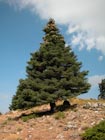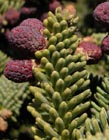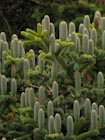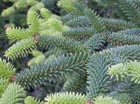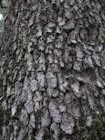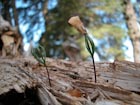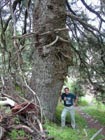Conservation Status

(subsp. pinsapo)

(subsp. marocana)
Abies pinsapo
Boiss. (1838)
Common names
Pinsapo, abeto español [Spanish], Spanish silver spruce, Spanish fir (van Gelderen et al. 1986, Vidakovic 1991).
Taxonomic notes
Two subspecies:
- A. pinsapo subsp. pinsapo, in Spain.
- A. pinsapo subsp. marocana (Trab.) Emb. & Maire (1928), in Morocco.
This is one of 8 species in Abies section Abies, the Mediterranean firs. See POWO for synonymy; most notably, many authorities recognize a variety tazaotana, differing only in having non-resinous foliage buds, and endemic to Mt. Tazaot in the Rif Mountains. Chloroplast DNA, however, shows that the marocana populations are all extremely similar, indicating that var. tazaotana is synonymous with subsp. marocana. The African populations are, however, highly distinct from the Spanish populations of var. pinsapo, with 85% of variance in cpDNA attributable to differences in African vs. European populations (Terrab et al. 2007). This, combined with observed morphological and ecological differences, indicates subspecies rank is appropriate for these taxa.
Description
Trees to 30 m tall and 150 cm dbh, usually with a single, round, straight trunk and a deep crown that is narrowly conical in young trees but irregular in older trees, comprised of long branches that ascend in the upper crown and curve downward in the lower. Trees in exposed sites may have very irregular form. Bark smooth, dark gray, with age becoming longitudinally fissured, rough and scaly. Twigs stout, very stiff (more than in perhaps any other species of Abies), red-brown or green-brown turning gray, glabrous, faintly ridged; leaf scars large, purple-gray. Foliage buds globose, 5 × 4 mm, very resinous; scales red-brown, triangular, keeled, free at the apex. Leaves spirally arranged, spreading radially and perpendicular to the branchlet, shade foliage somewhat pectinate but less so than in most species of Abies; 6-20 × 2-3 mm, not twisted at base, round or slightly flattened, rigid, apex obtuse or acute, stomatal bands on all surfaces, color from dark green to highly glaucous; two small medial resin canals; persisting for up to 13 years. Pollen cones lateral, crowded on branchlets, 5-7 mm long, yellow with red or violet microsporophylls. Seed cones on short peduncles, lateral, erect, cylindrical, with obtuse apex, 9-18 × 3-5 cm, green-purple ripening to brown; rachis persistent, narrowly conical, purple-brown. Seed scales triangular, 25-28 × 22-25 mm, smooth, slightly striated, upper margin entire, undulate, incurved. Bract scales 10-13 mm long, entirely included, oblong, the apex with a tiny cusp. Seed obovate, 6-10 mm long, light brown; the wing is twice this size, light brown; 1,000 seeds weigh ca. 50 g. Cotyledons 5-8. Flowers in April and May; cones mature in September and October (Farjon 1990, Vidakovic 1991). See García Esteban et al. (2004) for a detailed characterization of the wood anatomy.
Subsp. pinsapo has leaves with obtuse to acute apex, and medial resin canals. Seed cones 9-14 × 3-4 cm (Farjon 2010).
Subsp. marocana has leaves with acute to acuminate apex, and marginal resin canals. Seed cones 10-18 × 3.5-5 cm (Farjon 2010).
Distribution and Ecology
Spain and Morocco. Subsp. pinsapo occurs in Spain: the provinces of Malaga and Granada, in the Sierrania de Ronda (Sierra de las Nieves, S. de Bermeja and S. de Yunquera), at 1000-2000 m elevation. Subsp. marocana occurs in the Rif Mountains of N Morocco (Mts. Tissouka, Mago, Kraa, Tazaot, and Bab Rouida) at 1400-2100 m elevation (Farjon 2010).
Distribution of Abies in the Mediterranean region. Data from Conifers of the World BRAHMS database, downloaded 2017.11.05. Taxa are color coded; see pull-out menu at left of map for details. Click on each occurrence for further information.
Both subspecies grow on N-facing slopes on rocky soils derived from dolomitic limestone or serpentine, with deep drainage. The climate is montane Mediterranean: dry, warm summers and cool, moist winters, with annual precipitation around 1000 mm. The trees grow in pure, scattered stands (very rare in Spain) or mixed with Cedrus atlantica (Morocco) and Pinus pinaster (Spain). Other associates include broad-leaved trees such as Quercus ilex, Q. lusitanica, and Q. canariensis (Morocco), and sclerophyllous shrubs such as Ulex baliticus, Cistus spp., Pistacia lentiscus, Daphne laureola and Berberis hispanica (Farjon 1990). Hardy to Zone 6 (cold hardiness limit between -23.2°C and -17.8°C) (Bannister and Neuner 2001). In a physiological comparison to A. alba, Peguero-Pina et al. (2011) show that A. pinsapo is relatively much more drought tolerant and also much more vulnerable to tracheid cavitation in response to repeated freeze-thaw cycles. Both of these traits result from tracheids that have an unusually large diameter; this species' ability to survive in arid climates depends upon continuing to transpire in very hot, dry conditions. This suggests that A. pinsapo is at risk of drought-driven mortality, one of the more common consequences of global anthropogenic climate change.
The species has been reported as naturalized at locations in Spain and France. The largest of these is a 1913 plantation near Arcajo, Spain that has since naturalized (Peguero-Pina et al. 2011). Prioton (1964) produced a review of afforestation using A. pinsapo in France, and I have also received a report of a few naturalized trees near Le Pègue (near Nyons, France) on the dry and very steep limestone slopes around the track leading to Chapelle St Marcel (Jourdan 2020).
Remarkable Specimens
The Pinsapo de las Escaleretas is a very large, multi-trunked tree about 170 cm dbh and 26 m tall in the Parque Nacional Sierra de las Nieves (photos); it has been designated as a National Monument in Spain. Even larger trees are recorded in cultivation. A single-trunk specimen at the Palacio Real de La Granja in Spain is 185 cm dbh and 31.0 m tall (2015 measurement), and a tree in Le Hohwald, France is 38.8 m tall and 90 cm dbh (2020 measurement) (Monumental Trees 2025).
The oldest known specimen is documented in a tree-ring chronology covering the period 1689-1998 (crossdated after 1734), collected in the Sierra de las Nieves, Spain by M. Génova (doi.org/10.25921/gz33-r403). The oldest tree in the study provided a 310-year record. Greater age is attributed to the Pinsapo de las Escaleretas, but without any cited evidence.
Ethnobotany
Both subspecies were formerly exploited for timber, but reduced abundance and the creation of preserves have largely eliminated that. They remain popular in horticulture, particularly in areas of Mediterranean climate, where A. pinsapo is regarded as one of the most handsome firs. There are many cultivars, with glaucous and dwarf forms particularly popular; other cultivars are based upon hybrids with firs of section Abies and also with A. pindrow (Farjon 2010).
Observations
The largest subsp. pinsapo population is in the Parque Nacional Sierra de las Nieves. Nicholson (1986) gives an engaging account of traveling to see subsp. marocana.
Remarks
The epithet pinsapo is also the Andalusian common name for this fir.
"Seed bearing begins in the 25th to 35th year. Trees in natural stands in Spain bear a full seed crop every 3 to 5 years. Solitary plants may yield as much as 100 kg of cones per tree. 1 kg of cones contains 8-9 cones out of wich [sic] 250 g of seeds is extracted, i.e. cca 500 seeds. On the average, about 20,000 seeds are contained in 1 kg. Germination rate is, according to data from Spain (Catalan and Pardos, 1977) 50-60 percent, while in trees which are grown in other countries it is somewhat less. This fir may be successfully propagated by grafting" (Vidakovic 1991).
Farjon (1990) quite plausibly asserts that all populations of this taxon are isolated relicts of a much wider distribution in the past. It would be interesting to know how this species fared during the Pleistocene glacial maxima, when it presumably would have had a much lower elevational range.
Citations
Boissier. 1838. Notice sur l'Abies Pinsapo. Tiré de la Bibliothèque Universelle de Genève, p.8. Available: Real Jardín Botánico, accessed 2025.01.20.
Emberger, M. and R. Maire. 1928. Bulletin de la Société d'Histoire Naturelle de l'Afrique du Nord. Algiers. 19:245. Available: Real Jardín Botánico, accessed 2025.01.20.
Farjon, Aljos. 1990. Pinaceae: drawings and descriptions of the genera Abies, Cedrus, Pseudolarix, Keteleeria, Nothotsuga, Tsuga, Cathaya, Pseudotsuga, Larix and Picea. Königstein: Koeltz Scientific Books.
Jourdan, Stéphane. 2020. Les sapins espagnols « sauvages » du Pègue. La Lettre d'ALTONVM 36:16-19.
Monumental Trees. 2025. The thickest, tallest, and oldest Spanish Firs (Abies pinsapo). https://www.monumentaltrees.com/en/trees/abiespinsapo/records/, accessed 2025.01.20.
Nicholson, R. 1986. Collecting rare conifers in North Africa. Arnoldia 46(1):20-29. Available: arnoldia.arboretum.harvard.edu/pdf/articles/678.pdf, accessed 2010.02.12.
Peguero-Pina, José Javier; Domingo Sancho-Knapik; Hervé Cochard; Gonzalo Barredo; Dido Villarroya; and Eustaquio Gil-Pelegrín. 2011. Hydraulic traits are associated with the distribution range of two closely related Mediterranean firs, Abies alba Mill. and Abies pinsapo Boiss. Tree Physiology 31(10):1067–1075, https://doi.org/10.1093/treephys/tpr092.
Prioton, Jean. 1964. Plaidoyer pour le sapin d'Espagne. Revue Forestière Française 1964(2):99-115.
Terrab, A., S. Talavera, M. Arista, O. Paun, T. F. Stuessy, and K. Tremetsberger. 2007. Genetic diversity at chloroplast microsatellites (cpSSRs) and geographic structure in endangered West Mediterranean firs (Abies spp., Pinaceae). Taxon 56(2):409-416.
See also
Elwes and Henry 1906-1913 at the Biodiversity Heritage Library (Photos). This series of volumes, privately printed, provides some of the most engaging descriptions of conifers ever published. Although they only treat species cultivated in the U.K. and Ireland, and the taxonomy is a bit dated, still these accounts are thorough, treating such topics as species description, range, varieties, exceptionally old or tall specimens, remarkable trees, and cultivation. Despite being over a century old, they are generally accurate, and are illustrated with some remarkable photographs and lithographs.
Linares, Juan C. and José A. Carreira. 2009. Temperate-like stand dynamics in relict Mediterranean-fir (Abies pinsapo, Boiss.) forests from southern Spain. Annals of Forest Science 66:610-619.
Mediterranean conifer and mixed forests (PA0513), accessed 2010.02.12.
The species account at Threatened Conifers of the World.
Trees and Shrubs Online provides a horticultural perspective.


